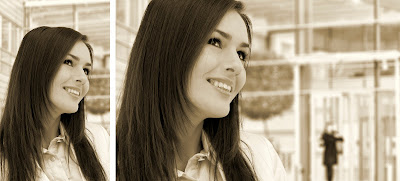Companies that use best practices as benchmarks can be motivated to improve their processes. But as C. K. Prahalad says in the April 2010 issue of Harvard Business Review, benchmarking against best pratices might "allow enterprises to catch up with competitors, but it won't turn them into market leaders. Organizations become winners by spotting big opportunities and inventing next practices."
Prahalad suggests looking at opportunities that are being created by the four billion people in places like China and India who are moving into the organized economy. Unilever and P&G, for example, are rethinking their geographical focus, anticipating that by 2020, 50% of their global revenues will come from poor people in the developing world.
He suggests that companies focus on solving big problems that will fuel big improvements—rather than following the leaders.
Source: HBR April 2010
Friday, April 30, 2010
Thursday, April 29, 2010
Client Showcase—LLU Identity
 Branding an organization that includes a university, a corporate entity and several hospitals required a flexible system that made clear the relationship between many entities. CMBell Company was asked to help Loma Linda University Adventist Health Sciences Center create a clear visual brand that brought together both its past legacy and its future dreams—and linked many individual entities to a strong master brand.
Branding an organization that includes a university, a corporate entity and several hospitals required a flexible system that made clear the relationship between many entities. CMBell Company was asked to help Loma Linda University Adventist Health Sciences Center create a clear visual brand that brought together both its past legacy and its future dreams—and linked many individual entities to a strong master brand. At their request, we updated their seal—which had undergone numerous changes throughout its history—and made it the anchor of their new visual identity. The regal red and grey color palette creates presence and suggests innovation, intensity of purpose and confidence; when combined with a modern layout, the overall look creates an impression of sophistication and strength.
Monday, April 26, 2010
What business are you really in?
 The railroads thought they were in the business of running railroads, which kept them from seeing bigger threats and opportunities. In reality, they were in the business of transportation, and it was air travel that posed the biggest threat—not faster or better railroads.
The railroads thought they were in the business of running railroads, which kept them from seeing bigger threats and opportunities. In reality, they were in the business of transportation, and it was air travel that posed the biggest threat—not faster or better railroads.This misguided view of one's true competition is still prevalent today. For example, healthcare at times suffers from a similar myopic viewpoint. Healthcare professionals see themselves as being in the business of saving lives and promoting health. But in fact, at times they are unable to fully promise either. Perhaps it is closer to the truth to say that they are in the business of restoring dignity and instilling hope—as well as offering medical interventions. Imagine how this idea might transform how hospitals deliver care.
Whatever your industry, think hard about what you are really selling. It may lead you to the next big idea—while failing to do so may prevent you from seeing your true competitive threats.
Thursday, April 22, 2010
Photo Techniques—Cropping People
When working with images of people, cropping doesn't mean 'chopping' out important bits of context or history. Rather, think of cropping as the act of cutting away unnecessary or unwanted portions of an image to help focus the viewers attention and help tell a story. Here are a few examples of reasons to crop:
 Focus Attention
Focus Attention
Cropping can help to make the primary focus or center of attention clear. Typical snap shots often lack a focal point, as does this example. Cropping is used to remove unwanted and distracting elements such as the high-rise on the left and cars in the background. Cropping has also eliminated the lamppost coming out of the top of the child's head.
 Create Movement
Create Movement
Consider how the viewer's eye moves across an image and allow for that movement. In a portrait of someone looking left to right, allowing space for them to look into brings meaning to the image. In this example, tight, centered cropping might not allow as much movement as a wider cropping would.

Rethinking the crop can serve to compliment the subject, help reinforce the composition and create a dynamic image. In this example, the original image is centered and ordinary. By cropping close on the face and using the rule of thirds, the tassel creates a strong vertical line and attention is drawn to the subject's eye.
Nearly any photo can be improved with good cropping.
 Focus Attention
Focus AttentionCropping can help to make the primary focus or center of attention clear. Typical snap shots often lack a focal point, as does this example. Cropping is used to remove unwanted and distracting elements such as the high-rise on the left and cars in the background. Cropping has also eliminated the lamppost coming out of the top of the child's head.
 Create Movement
Create MovementConsider how the viewer's eye moves across an image and allow for that movement. In a portrait of someone looking left to right, allowing space for them to look into brings meaning to the image. In this example, tight, centered cropping might not allow as much movement as a wider cropping would.

For Dynamic Effect
Rethinking the crop can serve to compliment the subject, help reinforce the composition and create a dynamic image. In this example, the original image is centered and ordinary. By cropping close on the face and using the rule of thirds, the tassel creates a strong vertical line and attention is drawn to the subject's eye.
Nearly any photo can be improved with good cropping.
Monday, April 19, 2010
Client Showcase—Hospital Brochure
 Flip through the pages of Avista Adventist Hospital's general brochure, and you'll see saturated, vivid photos of people living life to its fullest. Through color, language and images, the piece conveys health—the ultimate promise of healthcare.
Flip through the pages of Avista Adventist Hospital's general brochure, and you'll see saturated, vivid photos of people living life to its fullest. Through color, language and images, the piece conveys health—the ultimate promise of healthcare. So often, healthcare communications are permeated with images of intimidating equipment and patients in situations most of us hope to avoid. By conveying hope, vitality and health, Avista's brochure moves readers to see the powerful possibilities for their own life by making this hospital--with its goal of helping patients thrive--their healthcare provider.
Thursday, April 15, 2010
Printing Tip #2—Invest in the Relationship

In printed work, the printing of the job is where the final creative work takes place. The artisans in the print shop will make or break the project. They are essential partners in the process who will stand to contribute to both the creative and financial success of the project. So how does one make sure one is getting the best work for the money? There’s a fine line between balancing quality and price, and those who want to get the best of both worlds must be very savvy in both arenas. Here's the second in our series of tips on printing.
Invest in your relationship.
Quality printing comes from developing a relationship that requires communication and education. At the beginning of a relationship, we talk with our printers about our culture, our expectations, how we resolve differences, and how we define quality. We tour their shop, and ask about their processes. If they seem a likely match for our firm, then we begin the process of working with them over time to acquaint them with how we do business. With each new project, we develop a better understanding of how we can work together. This includes our learning about how we can work with them more effectively, too.
Stay tuned for more printing tips.
Monday, April 12, 2010
Branding Your Corporate Fleet
 Novant Health fleet graphics by CMBell Company
Novant Health fleet graphics by CMBell CompanyIf your corporate identity project includes a corporate fleet, here are things to consider:
- Readability from a distance
- Readability at night
- Readability in the mirror
Make sure you test the readability of the message at actual size before you go into production. Only when you see it full size will you know if it will be clearly visible.
Thursday, April 8, 2010
The Benefits of Outdoor Advertising
 Outdoor advertising reaches more people with fewer dollars. Out-of-home advertising costs three times less than radio and magazines, seven times less than newspaper and nine times less than network TV. It literally reaches more people more often with fewer dollars than any other form of media. And, more consumers are spending more time with out-of-home advertising than watching TV, reading the paper or listening to the radio.
Outdoor advertising reaches more people with fewer dollars. Out-of-home advertising costs three times less than radio and magazines, seven times less than newspaper and nine times less than network TV. It literally reaches more people more often with fewer dollars than any other form of media. And, more consumers are spending more time with out-of-home advertising than watching TV, reading the paper or listening to the radio.Not only does it cost less, it:
- Can't be turned off
- Can't be thrown away
- Can't be fast-forwarded
- Can be regionally targeted
Is outdoor part of your advertising mix? Perhaps it should be.
Monday, April 5, 2010
Toyota Recall: A Case Study
When things went south for Toyota this year, they responded with massive advertising. My first reaction was "Where are they getting their advice from?" The TV spots are confessionals—"we're not living up to our own standards or to yours"—planting doubt in minds that may not have had a negative opinion of Toyota.
Is there a time to admit fault? Yes, of course. But does this mean positioning a company as one that has disappointed America? I don't think so. Far better to spend those advertising dollars reminding America of all that is good about Toyota (which after all has an excellent track record when it comes to quality) and how they are responding to the problems with their vehicles. While I'm not objecting to them taking a proactive stance, I don't believe there's ever a time to create more bad news than actually exists.
Thursday, April 1, 2010
The Dove Commercial—Nobody's Perfect
Ogilvy & Mather's startling commercial takes us from model to billboard in under 60 seconds. Its an impressive spot from Dove, reminding us that even models don't look like models, and demonstrating the power of Photoshop.
Subscribe to:
Comments (Atom)
